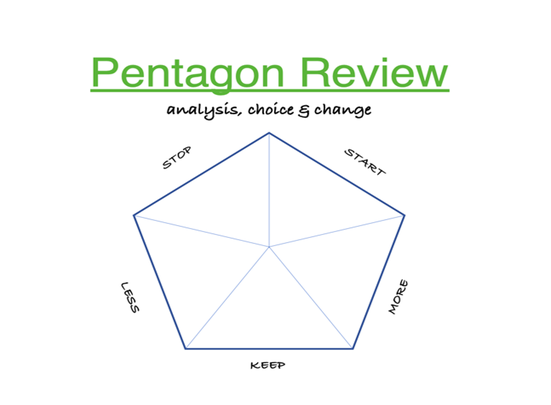Right now, most of what usually keeps us busy has stopped. How are we coaching at a time like this? In fact, now is the perfect time to undertake a full review of what is and what is not happening, gaining a 360 degree perspective on your practice so as to be ready for tomorrow.
A frequent question I ponder on in most of my coaching sessions is precisely this: how can I review a situation effectively, whilst including a clear sense of what actions to take next?
What was true when I started working as a coach fifteen years ago feels even more true today: ‘pay attention to the feedback loops to assess, review, evaluate and monitor’. Having recently completed my own review after a supervision session, I came across a model I had forgotten: the Pentagon Review. You may know this model by a different name, but in essence, it is a simple five-step process:
- What to keep?
- What to do less of?
- What to stop?
- What to do more of?
- What to start?

This tool is useful and applicable to many situations, for example: to review someone’s practice or project, to support someone in finding their ‘raison d’être’, or to review a particular process. In essence, it is an easy-to-grasp, easy-to-scale and highly valuable review model.
My recommendation? Start with ‘what to keep?’ This will illuminate what your coachee really stands for, boosting their self-confidence and strengthening the bond between the two of you. After this, follow the pentagon clockwise to finish with ‘what to start?’ This often sparks many new ideas and realisations. As you reach the end of the coaching process, you and your coachee will arrive at a sense of pragmatism and satisfaction. Furthermore, having taken stock, your coachee will now be ready to move into the next phase of development with a greater sense of accountability.
This said, what matters most is the quality of the conversation, so, use the model as a prompt and see where your coachee wants to go with it. This simple model allows spectacular progress in a small amount of time. It works at any level, in any type of organisation and does not require any particular training. It can bridge the gap between ‘doing something’ and engaging your coachee in a review process that supports both doing and thinking. It will reassure coachees who are in ‘delivery’ mode; by this I mean individuals who are used to ‘doing’ and who become lost when they are forced to sit back. The model has great value when used as a one-off, however it will be most efficient when utilised repeatedly over a period of time.
With Impact, I had fun combining the Pentagon Review Process with their models, Notice, Decide and Act (NDA) and Meaning, Value and Structure (MVS). Adding NDA and MVS into recent coaching dialogue led coachees to more impactful realisations. I might also try combining it with their Team Performance Indicator (TPI). How might you integrate the Pentagon Review Process into your practice?
Josselin Butte is a Coach and Business Consultant working with Impact as an Associate.
